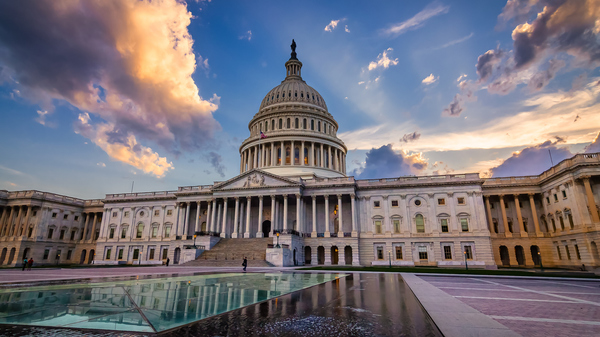DST in the USA: Is It Coming to an End?
Daylight Saving Time (DST) has been used in the US for more than 100 years, but it looks like it might be over soon.

The Sun might be setting on DST in the US for good. 18 states have passed legislations to get rid of the practice, but Congress still needs to give final approval.
©iStockphoto.com/Daniel Lange
NEWS: DST starts in the US 2025
18 American states have enacted permanent DST legislation. But it is Congress that has the final say on the matter.
The US is one of about 70 countries worldwide using Daylight Saving Time (DST), but Hawaii and most of Arizona don't use it.
When Does DST Start and End in the USA?
In the US, Daylight Saving Time begins on the second Sunday in March and is turned back again to standard time on the first Sunday in November as DST ends.
The change happens at 2 am local time.
Why do we have Daylight Saving Time?
Will the US Abolish Clock Changes?
On March 15, 2022, the US Senate unanimously passed the Sunshine Protection Act introduced by Florida Senator Marco Rubio. But for the bill to become law, allowing states to observe DST year-round, it must also be approved by the House of Representatives and signed into law by the President.
For now, current law only allows states to opt out of DST but not to follow it year-round.
Will Donald Trump “lock the clock”?
States That Want to “Ditch the Switch”
Currently, 18 states have passed legislation for permanent DST. Most likely, there are bills in other states too. More than 550 bills and resolutions have been considered at state level advocating for year-round DST, according to the .
| State | Year | Legislation | Goal |
|---|---|---|---|
| Colorado | 2022 | Permanent DST | |
| Mississippi | 2021 | Permanent DST | |
| Montana | 2021 | Permanent DST | |
| Alabama | 2021 | Permanent DST | |
| Minnesota | 2021 | Permanent DST | |
| Utah | 2020 | Permanent DST | |
| South Carolina | 2020 | Permanent DST | |
| Georgia | 2020 | Permanent DST | |
| Idaho | 2020 | Permanent DST | |
| Wyoming | 2020 | Permanent DST | |
| Louisiana | 2020 | Permanent DST | |
| Delaware | 2019 | Permanent DST | |
| Maine | 2019 | Permanent DST | |
| Oregon | 2019 | Permanent DST | |
| Washington | 2019 | Permanent DST | |
| Tennessee | 2019 | Permanent DST | Florida | 2018 | Permanent DST | Oklahoma | 2024 | Permanent DST |
Congressional approval needs to be in place for any state law to take effect.
Permanent Standard Time Also an Option
Meanwhile, a number of states are considering legislations that would end the seasonal time change but keep them on year-round standard time.
Any move to permanent DST requires national-level approval in the USA.
Because recent permanent DST bills have stalled in the US Congress, there have been more recent efforts to focus on a move to permanent standard time instead. Any move to year-round standard time does not require national-level approval.
Not All States Use DST
Almost all of the US states have yearly clock changes. The only exceptions are Hawaii and Arizona.
Hawaii observes Hawaii Standard Time (HST) all year.
Most of Arizona observes Mountain Standard Time (MST) year-round, except the Navajo Nation, because its territory extends into Utah and New Mexico—both states that observe DST.

Most of Arizona, including its capital, Phoenix, does not use DST.
©ľ±ł§łŮ´Çł¦°ě±čłó´ÇłŮ´Ç.ł¦´Çłľ/¶Ů°ů±đ˛ąłľ´Ú°ů˛ąłľ±đ°ů
Indiana decided to join the national DST regime in 2006 after abstaining from changing its clocks since 1970.
None of the US dependencies use DST, including American Samoa, Guam, Puerto Rico, the Northern Marina Islands, the US Minor Outlying Islands, and the US Virgin Islands.
History: When Did DST Start in the USA?
In 1916, during World War I, Germany became the first country to adopt DST to save energy for the war effort. Many countries across Europe soon followed suit. In the US, “Fast Time,” as it was called then, was first introduced in 1918. The initiative was sparked by Robert Garland, a Pittsburgh industrialist who had encountered the idea in the United Kingdom.
Only seven months later, DST was repealed. But some cities, including Pittsburgh, Boston, and New York, continued to use it.
“War Time” and “Peace Time”
In 1942, at the height of World War II, President Franklin D. Roosevelt reintroduced the measure, instituting year-round Daylight Saving Time in the US. Referred to as “War Time,” DST was in force continuously from February 9, 1942 to September 30, 1945.
During this time, the US time zones were called “Eastern War Time,” “Mountain War Time,” “Central War Time,” and “Pacific War Time.” After the surrender of Japan in mid-August 1945, the time zones were relabeled “Peace Time.”
National DST Rules since 1966
From 1945 to 1966, there were no uniform rules for DST in the US. This caused widespread confusion, especially for trains, buses, and the broadcasting industry. As a result, the was established. While granting US states the ability to opt out of DST, the law provided a framework for a nation-wide, synchronized DST schedule, starting on the last Sunday of April and ending on the last Sunday of October.
Year-Round DST in 1973
During the 1973 oil embargo, the US Congress ordered a year-round DST period lasting from January 1974 to April 1975. The rationale was to study the effects of seasonal time change on energy consumption. Following staunch opposition from the public and the realization that the measure yielded only modest energy savings, the plan was soon amended to allow for a return to standard time during the winter months.
Energy Policy Act of 2005
After the energy crisis was over in 1976, the United States DST schedule was revised several Â鶹ӳ» throughout the years. From 1987 to 2006, the country observed DST for about seven months each year. The current schedule was introduced by the Energy Policy Act of 2005 and has been followed since 2007.
Daylight saving or daylight savings?
While we diligently research and update our DST and time zone content, some of the information in the table above may be preliminary.
